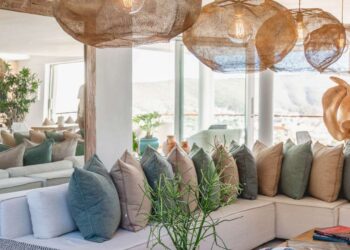The origins of today’s Marbella are the stuff of legend: In the 1950s, Prince Alfonso of Hohenlohe got stuck there when his Rolls-Royce broke down. At that point, the fishing village was still remote, so he decided to make the most of it and invited friends to enjoy this sliver of simplicity between La Concha Mountain and the Mediterranean Sea. Before long, assorted royals, celebrities, and billionaires joined the party. Things really took off when Prince Alfonso founded the Marbella Club, a glamorous hotel that Slim Aarons immortalized in photographs and that has hung onto its exclusivity. (Not so easy to do in the massified Costa del Sol.) In 1979, the city got a second jet-set hub, in the form of Puente Romano, which remains one of the best resorts in the Mediterranean today, and in 1994, David Shamoon acquired both resorts and set about cementing Marbella’s status. All the while, the glitz has remained underpinned by discretion and a carefree nature.
Worth Traveling For

There are celebrations galore for the anniversary this summer, including the launch of a sexy new Assouline book and the debut of a new plot of land at the Marbella Club that’s being sustainably developed with Deyrolle. Beyond that, it’s an increasingly year-round destination, like Dubai or Miami—thanks to a growing number of year-round residents from all over the world, and an outstanding microclimate.
“Last Christmas, Marbella had better weather than Miami,” says Daniel Shamoon, the son of David and managing director of Luxury Hotel Partners, whose projects include Puente Romano and the Marbella Club.
“Marbella is truly magical,” says Spanish actress and Hollywood talent agent Maria Bravo, who recently returned to live part-time in her native Marbella and hosts her lavish Global Gift Gala there. “The beach and the old town are something you don’t find anywhere else. And I’ve lived in Los Angeles, Tokyo, and Paris. There’s nothing like Marbella.”
Where to Stay

Puente Romano is the big resort that pulls off something rare: It feels like a village surrounded by lush gardens. The recently redecorated rooms fill separate blocks, each named for a town in the surrounding Andalusia region, with walking paths winding in between and the namesake Roman bridge — which dates from the 1st century — as a centerpiece. Its more than 20 restaurants include outposts of big-time brands like Cipriani, Coya, and Daní Garcia, plus the newly opened El Pimpi, a spinoff from the famous institution in nearby Málaga, in which Antonio Banderas is a partner.
The other classic choice is, of course, the Marbella Club, which remains a fierce defender of old-school European glamor. Its new, nature-focused addition is a game-changer, with plans for a slew of wellness and holistic programming in the gardens. An alternative from the same era is the family-owned El Fuerte Marbella, which opened in 2023 in a 1957 landmark building in the beachfront heart of Marbella’s city center, just a five-minute walk from the historic Plaza de los Naranjos in the Old Town.
Where to Eat

The Nobu restaurant in Puente Romano — which also has a hotel-within-the-hotel from Nobu — is said to be one of the best in the collection. As is the case with everything in the resort, the design is to-die-for, and the emphasis is on signature dishes paired with gin-based cocktails using indigenous botanicals. The menu of shareable plates hits all of Nobu’s Nikkei high notes: yellowtail sashimi with jalapeño, rock shrimp tempura, and black cod marinated in miso. For options outside the resorts, locals flock to Santiago — an institution since 1965 — for simply but perfectly cooked fresh fish and seafood, as well as more elaborate dishes, in front of the beach. Or they pop into the cozy Taberna la Niña del Pisto, a classic little spot in the old town for Andalusian tapas like boquerones, chorizo, and salmorejo (a thick cold soup of tomato, bread, and garlic).
Where to Play

Along with the world-class tennis clubs and brand-name spas (including the only Six Senses on the Spanish mainland) in the resorts, Marbella also has a slew of luxury boutiques from top luxury brands along its Golden Mile. Those destinations place Marbella in the league of much bigger cities, but it also has its own Mediterranean style of entertainment — elegant beach clubs and dressed-up nightlife. By day, a popular spot is La Plage Casanis, a newish venue that brings the old-school beach club vibes on the Estrella de Mar beach in Elviria, a few miles away from the city center. In summer, it has 200 hammocks in front of the sea, as well as day beds, a terrace, and an indoor section of the restaurant, which specializes in foods cooked on a wood-fired grill. Or there’s El Ancla, which is somewhat similar but with the addition of a large saltwater swimming pool and its special rice dishes like black paella with prawns and squid. And at night, the city’s fashionable set heads to Nota Blu, for what one socialite calls its “glitzy brasserie vibes,” where people dress to impress in a setting that takes part of its inspiration from glamorous New York jazz clubs.
Featured image courtesy of El Fuerte Marbella
Travel Curator may earn a commission from product or booking links on this page.







